Cuteness Overload and the Broken Wing Fraud
Many a times was I deceived by what seemed to be easy prey. And, as many a times, I did follow the trail of weakness just to end up frustrated, as her deceitfulness knows no boundaries. This time is different. Although tempted to follow her lure, I choose to remain on course and look for the reason she is orchestrating such a phony act. They should not be far away. They are now in hiding. This is the Killdeer sick and hurt act where the Killdeer mom simulates injuries by dragging her broken wing on the ground and limping away from you, the threat to her chicks’ safety. You take the time to follow the prey, as you think it’s a quick and effortless gain, but suddenly she miraculously heals and swiftly flies away from you and back to her chicks. You are now just a distant hazard. The immediate danger has passed.
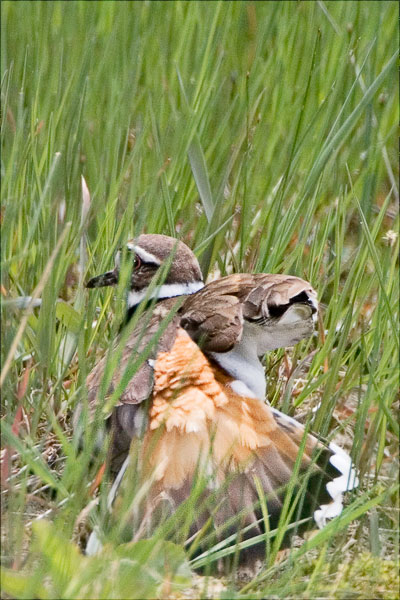
Killdeer Mom With "Busted Wing"
During the spring season, almost each nature photographic outing I undertake provides the opportunity to witness the act and entertain myself by either participating or carefully trying to get a glimpse of the Killdeer chicks nearby. In some instances the protective parent convinces me that she’s badly hurt, so she succeeds in leading the danger away. I leave the area and hope she’s continuing to improve her acting skills. Other times though, I’m not falling for her trickery and take the time to look around for Killdeer baby birds. They should be either frozen to the ground and skillfully hidden between rocks, or well camouflaged under bushes or tall grass. Today, it’s just that time. Today, I’m not going to be misled. I leave the Killdeer mom performing and I start looking around for the chicks. In total silence and in slow motion, it takes me 3-4 minutes to find the first Killdeer baby bird. The chick seems more curios than frightened, so it simply comes out from hiding and stands for a portrait session. The happy moments we experience! The Killdeer baby birds are precocial. From the very first day, immediately after hatching, Killdeer chicks are able to stand, run with their parents and feed themselves. I move ever so slowly to make this frame. Not that I have room to maneuver, but I try to position the baby bird between the camera and the sun and use the fill flash to add some light into the shadows. I lower the camera + the 500mm + 2x extender + 25mm of extension close to the ground and I kneel in the muddy water. As the cool temperature of the water reaches me, I arrange the chick’s head against the blue water and, paying attention to the rocks in the background, I finally immortalize the moment.
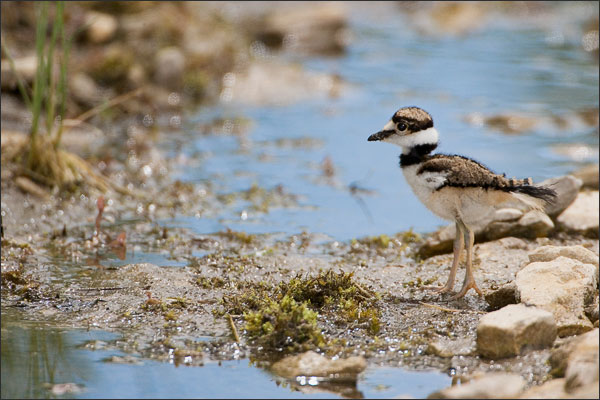
Killdeer Baby Bird Portrait
At the time of the photograph, the baby bird is covered in fluffy down which soon will be replaced with feathers. Young Killdeer will fly after 20-30 days after hatching. Here is a vertical layout close-up of the above frame:
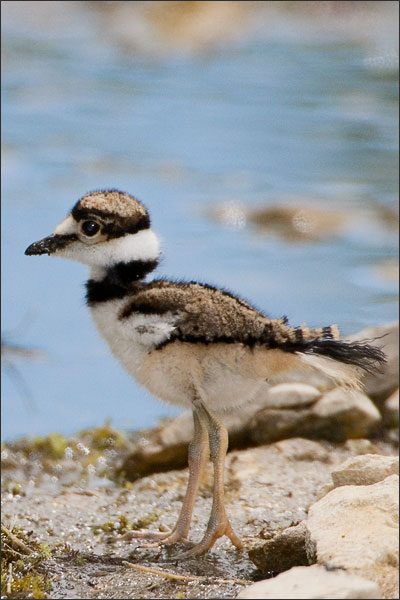
Killdeer Baby Bird Portrait – Vertical Layout
For just a split second the Killdeer baby bird forages through a patch of small plants. That’s long enough to capture the next frame. Its tail aligns with the rock having the sky-blue water as the background. So cute!
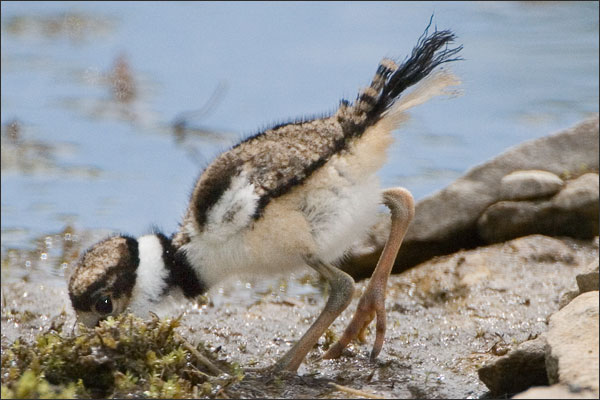
Killdeer Baby Bird Foraging
A second Killdeer baby bird appears from the grass-covered edge and stands shy a few meters from the camera. Curiosity and the relaxed attitude of its brother (or sister) tell this baby bird that the danger has passed. I realize now I’m photographing a brood of 2. Different light conditions come into sight so I adjust camera settings, cautiously align the lens in the proper direction and record the vertical layout portrait as follows:
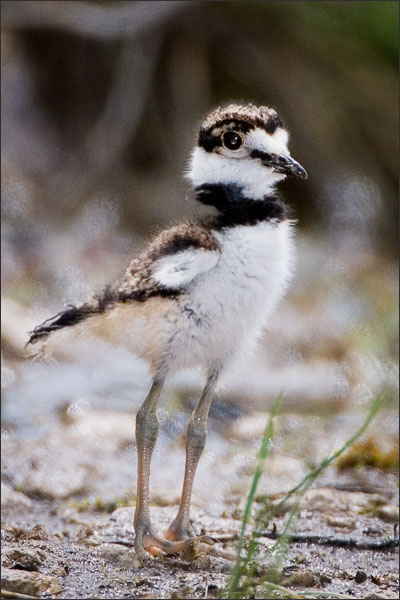
Killdeer Baby Bird Portrait – Vertical Layout
The Killdeer baby birds in the above photographs are about 9-10 cm tall. The tiny strands of grass in the foreground, the wet mud and the light sparkles reflecting from the water beads just paint the picture of this bird’s preferred habitat. The photographer in me leveled its head against the dark, out-of-focus, background. Cool fact: Similarly to the Killdeer behaviour, other bird species feign weakness and injury to lure away threats from nest or chicks. I left the area after a good 20 minutes of photographing these common but interesting birds. Who knows? Maybe next time I will take again the strenuous path of deceitfulness and treachery. Next week’s story will illustrate the beautiful Eastern Bluebird. I also hope we will have time to continue with our Point Pelee photo assignment.